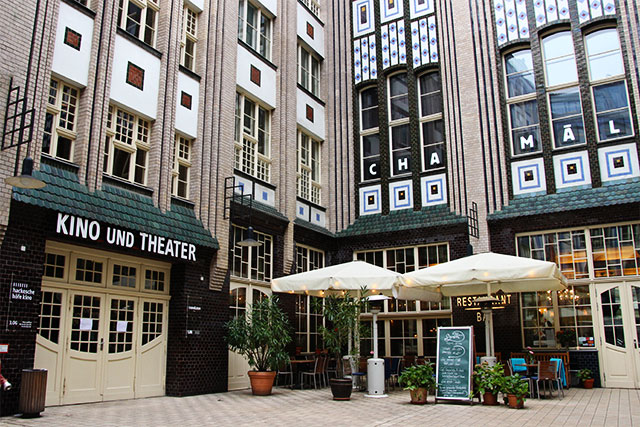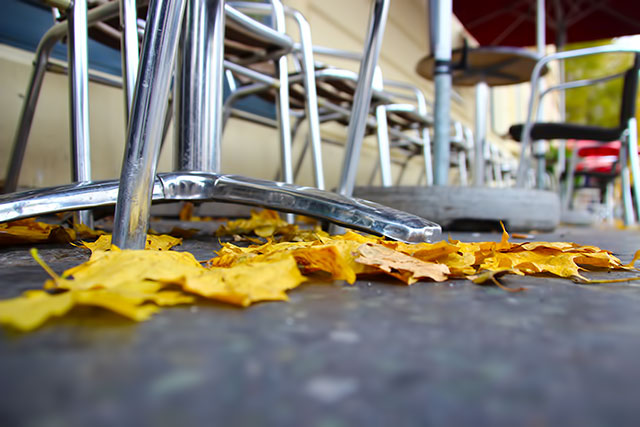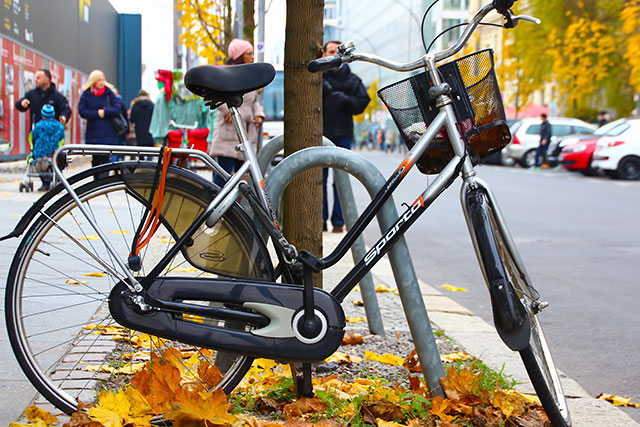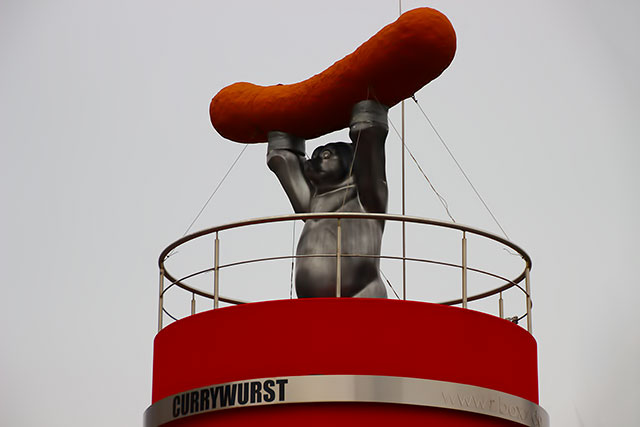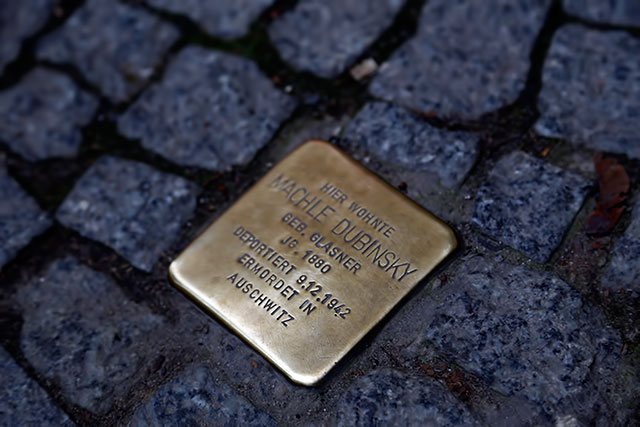 |
| The Jewish history is written on East Berlin's pavements |
We started our second day in Berlin with a tour of East Berlin. From the doorstep of The Circus Hotel where we were hosted we could see
the Berlin Tower, originally a radio and television transmitter, but built with an underlying motivation - to create a powerful political symbol that could be seen from West Berlin.
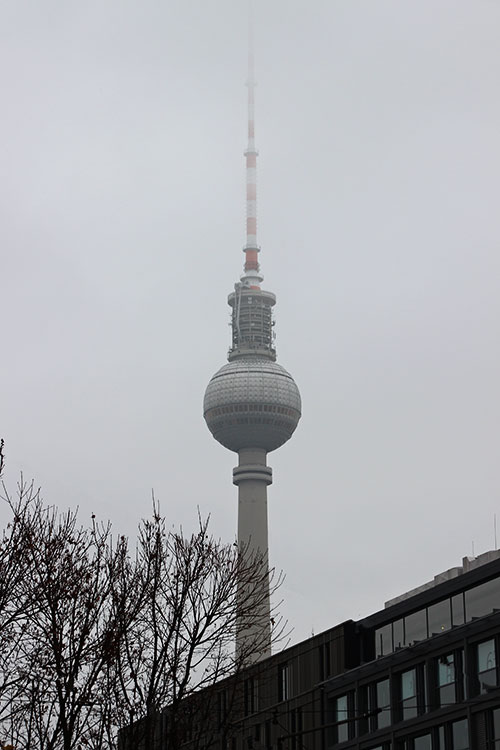 |
| The Berlin Tower |
The Tower also hosts a restaurant with amazing views over the vast city, but what always impressed me most were my mother-in-law's stories of when she visited East Berlin during the communist regime and from the Tower she could spot two very different realities - at night, West Berlin was all lit up like a Christmas tree, while East Berlin would remain covered in darkness.
"Berlin is poor, but sexy", said Klaus Wowereit, Berlin's mayor, in 2004. Truth is, Berlin still has the feeling of a scared city, in spite of the overall economical growth of Germany. And while the concrete walls had been torn down almost entirely - only three long sections of the Berlin Wall are still standing to make a statement - invisible walls still divide the city.
East Berlin became trendy in the last years. People started moving here for economical reasons, since buying and renting here continues to be relatively cheaper than on the West side of the city. No wonder, since all what people from the former East Bloc wanted was to move West. The communist built buildings had been transformed into luxury apartments, with fancy inner courtyards where boutique shops mingle with charming cafés and a hidden cultural scene. And I have to admit fall was suiting the city to perfection, adding magic to pavements and walls.
What struck us nevertheless was the quietness in which everything was wrapped. It was like time stubbornly decided to stay still that cold November day. The washed up sky and the concrete color of the buildings was creating a gloomy atmosphere that hanged down heavily on our spirit.
We managed to squeeze a smile at the sight of the Ampelmännchen, the male figure wearing a hat used as a symbol on pedestrian signals in the former East Germany.
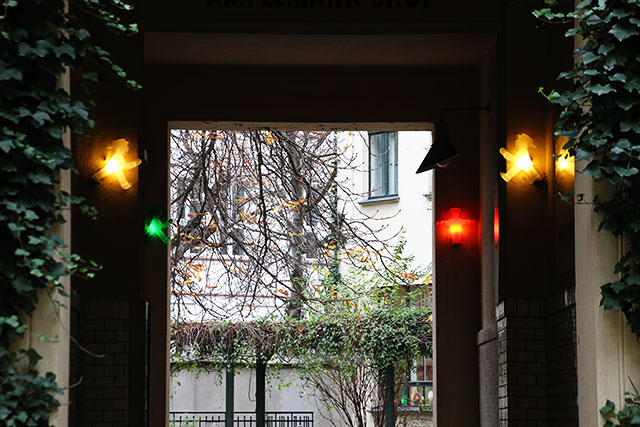 |
| The Ampelmännchen |
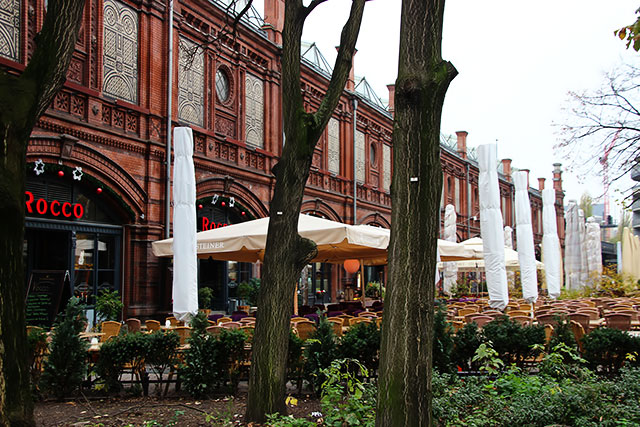 |
| One of Berlin's train stations, on a very quiet and very cold November morning |
However, after taking the train to
the Berlin Wall, the heavy feelings returned. The Berlin Wall was erected in one single night of August, in 1961, thought it took longer to consolidate and fortify it. And though the Eastern Bloc claimed that the wall was erected to protect its population from fascist elements, the reality was quite the opposite - the Wall served to prevent people from the Eastern Bloc migrate to the West.
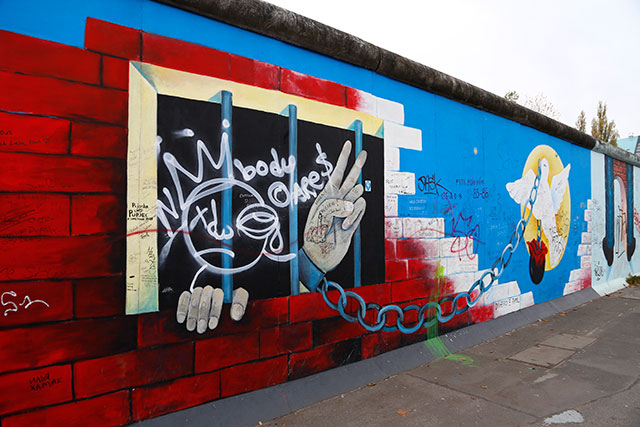 |
| Peace messages on Berlin Wall |
But a wall is never just a wall, not when it cuts off contact between family members. Often called 'The Wall of Shame' or the 'Iron Curtain', the Berlin wall was heavily protected on the East side. Thousands of people tried to escape the communist regime by climbing the wall, and hundreds died in the process, though the numbers are disputed. The 'death strip' was a dangerous place to be.
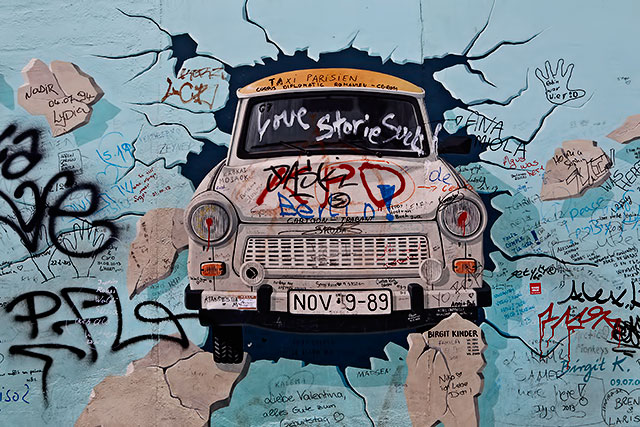 |
| Trabi breaking though the Berlin Wall. The Trabant was East Germany's answer to the VW Beetle |
West Germans and citizens of other Western countries could generally visit East Germany, often after applying for a visa. But things were not at all that pink on the other side of the wall, and with very few exceptions, one could not travel to the West.
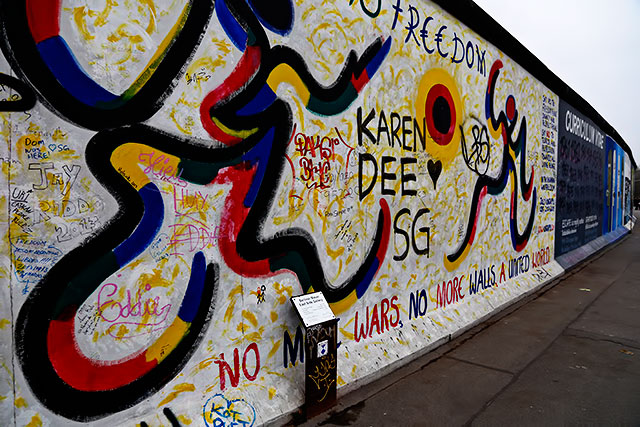 |
| Peace messages on Berlin Wall |
After 1990 the Berlin Wall was almost entirely destroyed. The largest part still standing is covered in colorful graffiti, mostly carrying messages of peace, though to be honest, many scenes are defamed, while new ones are being added.
The Berlin Wall is alive.
After the Berlin Wall, we went to see Checkpoint Charlie. This was the best-known Berlin Wall crossing point between East Berlin and West Berlin during the Cold War.
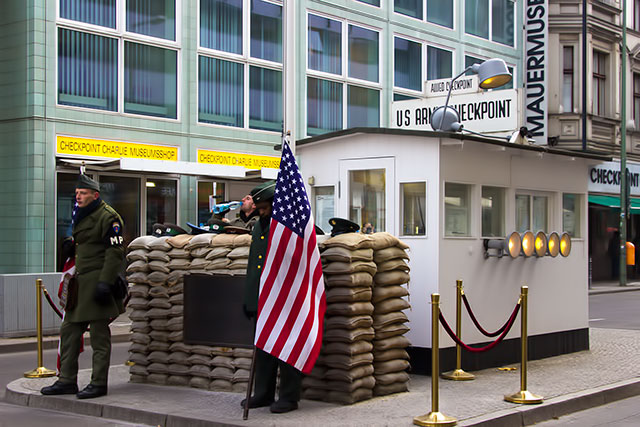 |
| Checkpoint Charlie |
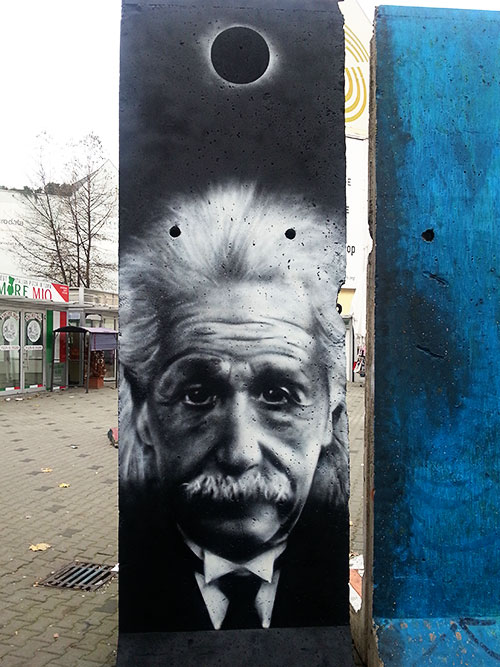 |
| Einstein on a piece of Berlin Wall close to Checkpoint Charlie |
Nowadays it is a tourist attraction, surrounded by souvenir stalls and shops selling Soviet military hats and Trabi miniatures. The
Checkpoint Charlie Museum is just next to it and the
Trabi Museum is down the street.
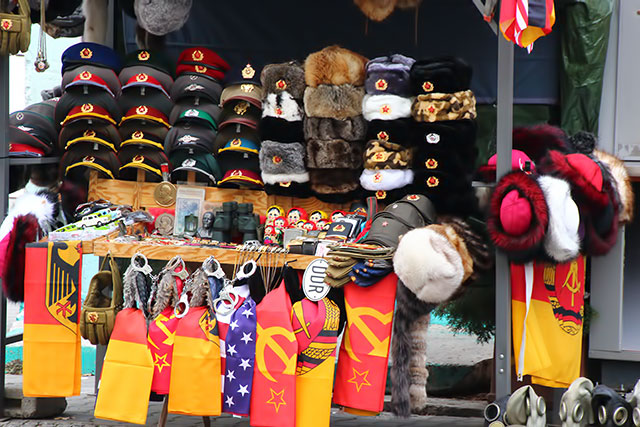 |
| Souvenir shop next to Checkpoint Charlie |
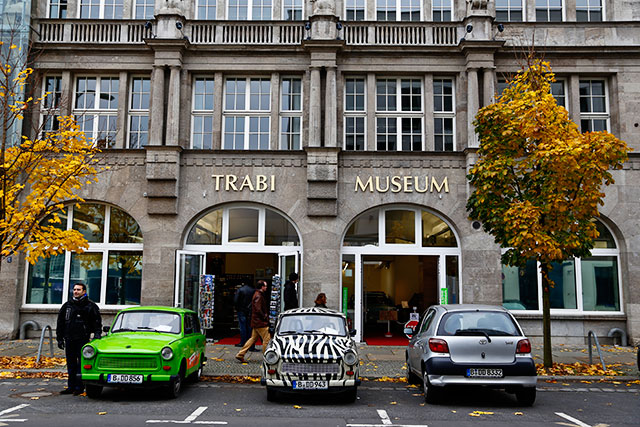 |
| The Trabi Museum in Berlin |
It amused me that there were three guys making a living masquerading in front of Checkpoint Charlie dressed as American and Russian military for the amusements of the tourists eager to have their picture taken with them. But I found it even more hilarious that just across the street the currywurst stall was called 'Checkpoint Curry'.
Currywurst is an institution in Berlin. We had to try the 'Checkpoint Curry' ones, and they were decent. But they couldn't top the currywursts they serve on the airberlin flights, which are by far our favorites.
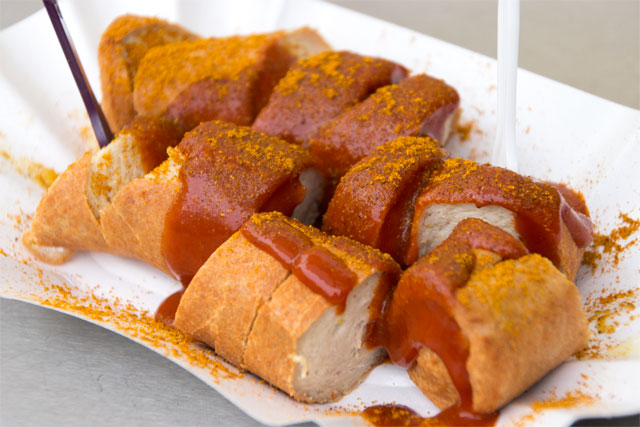 |
| 'Checkpoint curry' currywurst |
The currywurst was invented in Berlin in 1949, after Herta Heuwer, a local entrepreneur, obtained ketchup, Worcestershire sauce and curry powder from British soldiers. In the meantime Berlin even hosts a museum entirely dedicated to its most famous fast food dish.
After Checkpoint Charlie we walked our way to Brandenburg Gate and finished with a stroll thorough Tiergarten Park before taking a domestic flying to Dusseldorf with airberlin. We spent less than 24 hours in Berlin this time, but it left us longing for more...
Our end of the year trip to Germany with airberlin not only brought us to East Berlin, the Berlin Wall and Tiergarten Park in Berlin, but also to Fassbender & Rausch, the largest chocolaterie in the world. Rausch is the company behind the...
Visiting Dresden in mid-November proved to be a double-edged sword. The Christmas Market wasn't going to open until the end of the month, however, the city was already infused with festive charm. We had the chance to walk among the quiet stalls...
After spending the morning strolling along the history rich streets of the former East Berlin and visiting the Berlin Wall, my husband and I insisted on making one more stop before our flight to Dusseldorf with airberlin. We strongly felt we could...
Despite rapid gentrification, rising rents and an influx of big business into the once divided city, Europe's "capital of cool” is still a great place to take a bargain break. Historically rich, culturally vibrant and famous for its liberal attitudes,...
Everyone has their own idea of what makes a perfect holiday. For some it's wherever they can fly cheaply for sun, surf and adventure. For others, it's fine dining experiences and strolls among the shops. But for booklovers, there can be few holidays...
